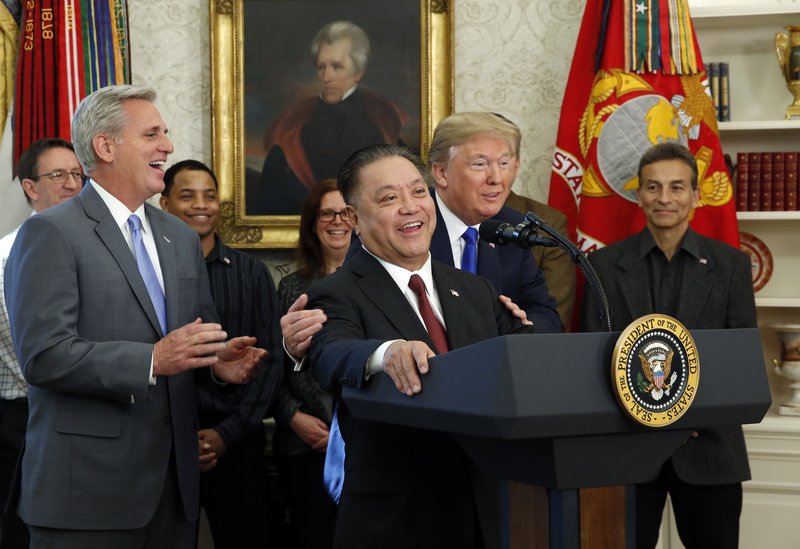這位高管去年的報(bào)酬是美國(guó)普通上班族的2000倍

|
半導(dǎo)體公司博通(Broadcom)首席執(zhí)行官陳福陽(yáng)以1.032億美元的薪酬成為2017年工資最高的美國(guó)大公司CEO,。 《華爾街日?qǐng)?bào)》報(bào)道,在陳福陽(yáng)之后分列二、三位的分別是哥倫比亞廣播公司(CBS)CEO萊斯·穆維斯(6930萬(wàn)美元)和航空零部件制造商Transdigm掌門人尼古拉斯·哈維(6100萬(wàn)美元),。 2017年陳福陽(yáng)的基本工資為110萬(wàn)美元,,超額完成2017年收入和營(yíng)業(yè)利潤(rùn)率目標(biāo)為他帶來(lái)了370萬(wàn)美元的績(jī)效獎(jiǎng)金。他的九位數(shù)薪酬還包括:往返于公司和賓夕法尼亞州住所產(chǎn)生的差旅費(fèi),,約為23234美元(博通已在今年4月將總部從新加坡遷至美國(guó)加州),,公司按401(K)計(jì)劃為他繳納的16200美元養(yǎng)老金以及36386美元的出租車費(fèi)。 不過(guò),,博通提交給監(jiān)管部門的文件顯示,,陳福陽(yáng)拿到了9830萬(wàn)美元的公司股票獎(jiǎng)勵(lì),與之相比上述收入簡(jiǎn)直不值一提,??傊惛j?yáng)的酬勞達(dá)到了1.032億美元,,同比上漲約318%,。 僅在數(shù)字層面比較,陳福陽(yáng)的收入是美國(guó)普通上班族的2039倍——美國(guó)勞工統(tǒng)計(jì)局(Bureau of Labor Statistics)的數(shù)據(jù)顯示,,后者的薪酬為50620美元,。 但情況沒有那么簡(jiǎn)單。上述9830萬(wàn)美元股票酬勞不會(huì)馬上進(jìn)入陳福陽(yáng)的腰包,。相反,,這些股份將在2020和2021年發(fā)放,而且陳福陽(yáng)能拿到的股票數(shù)量還將取決于當(dāng)年底博通的股價(jià),。 舉例來(lái)說(shuō),,如果博通跑贏90%的標(biāo)普500指數(shù)成份股,那么到2021年陳福陽(yáng)就可以獲得價(jià)值1.792億美元的股票,。但反過(guò)來(lái),,如果博通的股價(jià)落后于75%的標(biāo)普500指數(shù)成份股,陳福陽(yáng)就拿不到任何股票酬勞,。 許多公司都采用了這樣的薪酬結(jié)構(gòu),,其作用是長(zhǎng)期留住CEO,同時(shí)將其收入和公司的經(jīng)營(yíng)狀況掛鉤,。這樣做的邏輯是,,它能更多地促使CEO去改善和發(fā)展自己的公司,而不是基于短期效益進(jìn)行決策,。 不過(guò),,就算考慮到這一點(diǎn),我們?nèi)匀缓茈y否認(rèn)CEO和普通上班族的收入差距令人震驚,?!度A爾街日?qǐng)?bào)》指出,,2017年各位CEO的薪酬至少比上年提高了9.7%,而公司員工的平均時(shí)薪漲幅為2.9%,。 這樣的情況屢見不鮮,。經(jīng)濟(jì)政策研究所(Economic Policy Institute)的研究顯示,剔除通脹因素后,,1987-2014年CEO的收入上升了997%,,遠(yuǎn)高于普通勞動(dòng)者10.9%的漲幅。但國(guó)會(huì)議員和監(jiān)管部門目前正在為了縮小這個(gè)差距而調(diào)整稅法和報(bào)稅標(biāo)準(zhǔn),。美國(guó)證券交易委員會(huì)(The Securities and Exchange Commission)現(xiàn)在要求公司披露薪酬比例,,特別是普通員工和CEO的收入差距(博通的2017財(cái)年從2016年10月開始,因此不必披露該數(shù)據(jù),,只有2017財(cái)年始于2017年1月1日之后的公司需要披露此項(xiàng)年度數(shù)據(jù)),。 此外,唐納德·特朗普總統(tǒng)2017年簽署的稅收法案廢除了一項(xiàng)抵減績(jī)效薪酬稅額的規(guī)定,。此前,,CEO績(jī)效酬勞的起稅點(diǎn)為100萬(wàn)美元,而且基于績(jī)效的其他所有收入也都免稅,。按照新法案,,美國(guó)聯(lián)邦政府在隨后10年里預(yù)計(jì)將增收93億美元,。 這些變化能否影響CEO薪酬不斷上升的趨勢(shì)仍有待觀察,。(財(cái)富中文網(wǎng)) 譯者:Charlie 審稿:夏林 |
The title of highest-paid CEO among the U.S.’s largest companies goes to Broadcom executive Hock Tan, who earned $103.2 million in 2017. The semiconductor company’s CEO beat out second place Les Moonves, CEO of CBS($69.3 million), and third place W. Nicholas Harvey, CEO of aerospace components maker Transdigm’s ($6l million), according to the Wall Street Journal. In 2017, Tan had a base, cash salary of $1.1 million, plus a performance bonus of $3.7 million for exceeding revenue and operating margin targets in the year. Also wrapped into his nine-digit payday: some $23,234 in travel expenses for Tan to travel to his Pennsylvanian residence (Broadcom completed its move from Singapore to California in April), as well as $16,200 in 401(K) employer matching contribution, and another $36,386 for car service. But all of that pales in comparison to the shares Broadcom awarded to Tan that had a value of $98.3 million, according to regulatory filings. All together, Tan earned $103.2 million—about 318% higher than a year earlier. And so on the face of it, Tan earned roughly 2,039 times more than the average U.S. worker, who pulled in $50,620 according to the Bureau of Labor Statistics. Still, it’s not as simple as that. That $98.3 million in stock awards won’t be immediately available to Tan. Instead, those stock awards will vest in 2020 and 2021, while the number of shares Tan will be eligible for will also depend on the value of Broadcom shares at the end of those two periods. For example, if Broadcom shares perform better than 90% of companies in the S&P 500, Tan would be eligible for shares worth $179.2 million by 2021. Though on the flip side, if Broadcom shares perform worse than 75% of S&P 500 companies, Tan will receive no shares. The compensation structure, common in many companies, is used to keep CEOs in their jobs over the long run, while tying their compensation to the company’s health. In doing so, the logic goes, chief executives are more motivated to improve and grow their company rather than making decisions based on the short term. Even when factoring that in, however, it is hard to deny that the gap in pay between CEOs and the average worker is startling. According to the Journal, CEOs received raises of 9.7% or better compared to last year. Average hourly earnings for all U.S. workers, in contrast, rose 2.9%. It’s no new trend. Adjusted for inflation, CEO pay skyrocketed 997% between 1987 and 2014—vastly outpacing the 10.9% gains made by the typical workers, according to a study from the Economic Policy Institute. But lawmakers and regulators are now making changes to tax laws and reporting standards in the hopes of addressing that gap. The Securities and Exchange Commission now requires companies to include pay-ratio disclosures, particularly the difference between median worker pay and that of the chief executive (Broadcom did not have to make that disclosure, as its fiscal 2017 year began in October 2016. Only companies reporting after Jan. 1, 2017 reported the ratio this year). Separately, the tax bill signed in 2017 by President Donald Trump also does away with a tax deduction for performance-based pay. Previously, the first $1 million in executive pay was tax exempt—though any additional pay based on performance was also exempt. Under the new law, the federal government is expected to collect $9.3 billion more over a 10-year period. Whether these changes will have an impact the trend of ever-rising CEO pay remains to be seen. |













